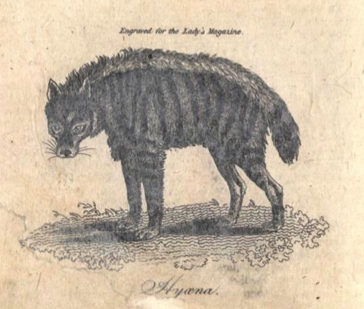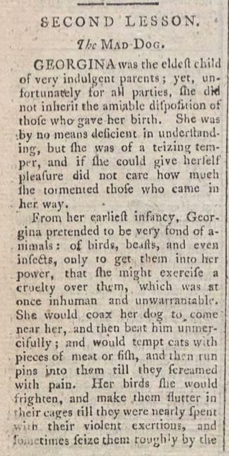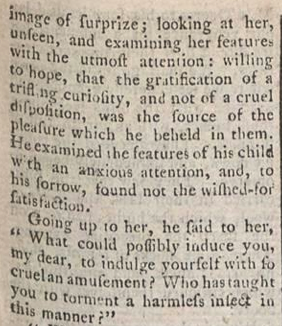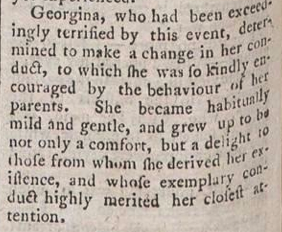Representations of animals and children abound in the Lady’s Magazine; I have written  previously about John Legg’s love of wildlife and sympathy for hunted hares and foxes. Poems focusing on pets are common and range from the melancholy – ‘Verses written on the Death of Deborah’s Cat’ (LM XII [Sept 1782]: 495), to the curious – ‘Verses by a Gentleman to his Bird on his Parting with it to a Lady’ (LM VII [Dec 1776]: 661), to the downright odd – ‘Inscriptions on two monkey’s collars’ (LM XXII [May 1791]: 272). Serial features such as John Legg’s ‘Ornithology; or, A New and Complete Natural History of English Birds’ (1782-85) and Ann Murray’s ‘The Moral Zoologist’ (1800-05) provide the magazine’s readers with anecdotal and scientific information on animals both close to home and exotic. Across the genres, including tales that demonstrate the loyalty of dogs or the anecdotes regarding the sagacity of insects, animals are a frequent topic for the magazine’s contributors.
previously about John Legg’s love of wildlife and sympathy for hunted hares and foxes. Poems focusing on pets are common and range from the melancholy – ‘Verses written on the Death of Deborah’s Cat’ (LM XII [Sept 1782]: 495), to the curious – ‘Verses by a Gentleman to his Bird on his Parting with it to a Lady’ (LM VII [Dec 1776]: 661), to the downright odd – ‘Inscriptions on two monkey’s collars’ (LM XXII [May 1791]: 272). Serial features such as John Legg’s ‘Ornithology; or, A New and Complete Natural History of English Birds’ (1782-85) and Ann Murray’s ‘The Moral Zoologist’ (1800-05) provide the magazine’s readers with anecdotal and scientific information on animals both close to home and exotic. Across the genres, including tales that demonstrate the loyalty of dogs or the anecdotes regarding the sagacity of insects, animals are a frequent topic for the magazine’s contributors.
Likewise , children are ever-present in the magazine. In fiction, they appear in sentimental or moral tales such as Memoirs of a Young Lady (1783-86) or The Happy Discovery (LM XIX [March 1788]: 142) as beautiful and sweet, orphaned innocents. They are the focus of (sometimes terrifying) medical advice, the subject of advice queries to the Matron, or the characters in serial novels dealing with the trials of their management (‘The Mother-in-Law, 1785-86). And sometimes they are the intended readers of the items themselves.
, children are ever-present in the magazine. In fiction, they appear in sentimental or moral tales such as Memoirs of a Young Lady (1783-86) or The Happy Discovery (LM XIX [March 1788]: 142) as beautiful and sweet, orphaned innocents. They are the focus of (sometimes terrifying) medical advice, the subject of advice queries to the Matron, or the characters in serial novels dealing with the trials of their management (‘The Mother-in-Law, 1785-86). And sometimes they are the intended readers of the items themselves.
This is the case for the serial fiction ‘Domestic Lessons for the Use of the Younger Part of the Female Readers of the Lady’s Magazine’ (LM XVII [Supp 1786]: 705 – LM XXI [March 1790]: 137), a long-running feature that is comprised of a series of short, instructive tales with a moral or conduct lesson. The anonymous serial was introduced by the editors in the 1786 supplement as a work ‘never before published’ (LM XVII [Supp 1786]: 705) and in spite of my efforts, its authorship remains unknown. Many of the short tales within the serial feature animals as well as children, with unsettling results. One of the more disturbing tales is the ‘second lesson’, entitled ‘The Mad-Dog’.
The lesson revolves around a father and mother’s attempts to cure their daughter, Georgina, of her ‘teizing temper’ that displayed itself, from a very young age, in cruelty towards animals. Georgina Sagely, ‘from her earliest infancy [. . .] pretended to be very fond of animals: of birds, beasts, and even insects, only to get them into her power, that she might exercise a cruelty over them, which was at once inhuman and unwarrantable. She would coax her dog to come near her, and then beat him unmercifully; and would tempt cats with pieces of meat or fish, and then run pins into them till they screamed with pain’ (LM XVIII [April 1787]: 202). While the parents are described as ‘very indulgent’, the author implies both from her behaviour displaying itself from infancy, and from the presence of two brothers who are kind to animals, that the fault is inherent in Georgina rather than the result of her parents’ indulgency.
 Georgina continues to mistreat and torment the animals around her when, at age 15, her father takes away the animals under her care. The incident that follows is distinctive in its perspective. Mr. Sagely looks for his daughter and finds her in the garden and, observing her before she seems him, he realizes she is ‘spinning a cock-chaffer, suspended by a thread, which had been fixed to a crooked pin piercing its tail’ (LM XVIII [April 1787]: 203). The point of view here moves from an omniscient narrator to a limited third-person narration in which the reader sees Georgina from her father’s point of view, and is closely aligned with his thoughts as he watches his daughter, unable to access her feelings.
Georgina continues to mistreat and torment the animals around her when, at age 15, her father takes away the animals under her care. The incident that follows is distinctive in its perspective. Mr. Sagely looks for his daughter and finds her in the garden and, observing her before she seems him, he realizes she is ‘spinning a cock-chaffer, suspended by a thread, which had been fixed to a crooked pin piercing its tail’ (LM XVIII [April 1787]: 203). The point of view here moves from an omniscient narrator to a limited third-person narration in which the reader sees Georgina from her father’s point of view, and is closely aligned with his thoughts as he watches his daughter, unable to access her feelings.
‘He stood, for a moment, the image of surprise; looking at her, unseen, and examining her features with the utmost attention: willing to hope, that the gratification of a trifling curiosity, and not of a cruel disposition, was the source of the pleasure which he beheld in them. He examined the features of his child with an anxious attention, and, to his sorrow, found not the wished-for satisfaction’ (LM XVIII [April 1787]: 203).
 What is intriguing about this scene is not only the shift in narrative perspective, but also in the emotional complexity of the father. This is no simple, formulaic moral tale; Mr. Sagely’s anxiety is palpable: he wants to believe his daughter does not torture the insect for pleasure but for, perhaps, a scientific curiosity. But he can delude himself no longer. When she goes onto so torment the family dog that he knocks her over, she retaliates by putting a rope around his neck and dragging him around the yard until he bites her. Her parents seize upon this as an opportunity to terrify her, hoping it will cause her to change her behavior, and tell her the dog is mad and that she may catch the disease. She is put into a straight-coat, confined, and threatened with being thrown into the sea as a treatment.
What is intriguing about this scene is not only the shift in narrative perspective, but also in the emotional complexity of the father. This is no simple, formulaic moral tale; Mr. Sagely’s anxiety is palpable: he wants to believe his daughter does not torture the insect for pleasure but for, perhaps, a scientific curiosity. But he can delude himself no longer. When she goes onto so torment the family dog that he knocks her over, she retaliates by putting a rope around his neck and dragging him around the yard until he bites her. Her parents seize upon this as an opportunity to terrify her, hoping it will cause her to change her behavior, and tell her the dog is mad and that she may catch the disease. She is put into a straight-coat, confined, and threatened with being thrown into the sea as a treatment.
At length, the Sagely’s duplicity is rewarded: Georgina is so traumatized by the ordeal that she is ‘restored to [her] reason’ but warned by her parents never to lose her ‘proper’ senses again lest she be ‘more severely punished, in a manner you have not yet experienced’ (LM XVIII [June 1787]: 314). The cure appears permanent, and Georgina becomes ‘not only a comfort, but a delight’ to her parents and displays henceforth exemplary conduct.
While the ‘lesson’ of the tale is dubious at best, and certainly modern-day readers would question the efficacy of such parental conduct to cure a cruel disposition, the author’s use of narrative shift and the depth of the father’s concern are distinctive. This is more than a standard conduct or moral lesson; it reveals the anxiety and fear experienced by parents who feel helpless to understand or change their child’s inherent propensity for cruelty and torture.
The serial remains an elusive installment in the periodical; it ends in 1790, unfinished, and no further mention of it or the anonymous author appears. And while the magazine’s frequent publications featuring animals and children are an enduring and fascinating aspect of its content, as readers, perhaps, we are happier when the two do not meet as they do in the ‘The Mad-Dog’ of ‘Domestic Lessons’.
Jenny DiPlacidi
University of Kent

On the website of Martyn Edgell, antique dealer, is a child’s small pottery mug printed with a scene of a boy being tossed by a bull with the admonishment “Effects of Teizing”. The mug must post-date 1800-1805 because of the purple lustre band and probably dates to c. 1820.